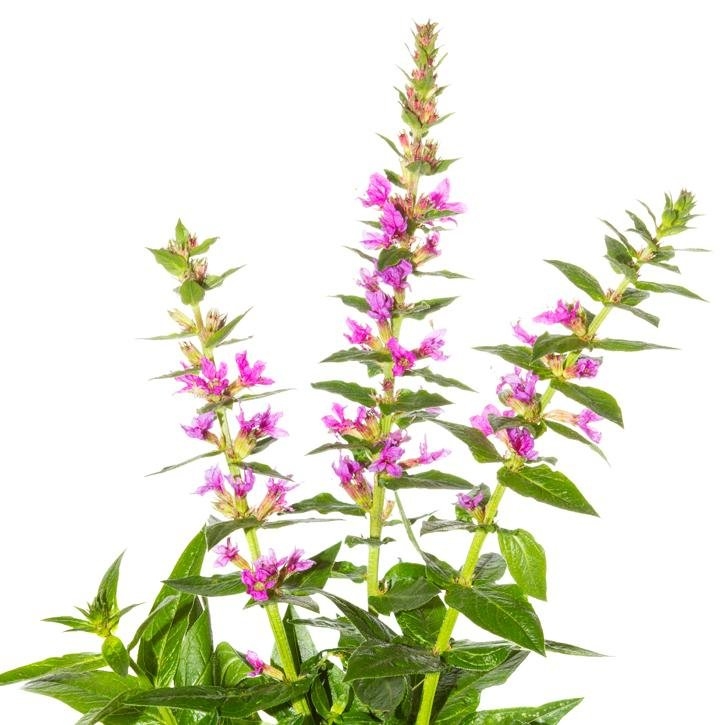Description
It’s a vivacious, erect plant of quadrangular stem of 30 cm to 1.50 m high, pubescent at the upper end. Stems are brownish-green, rigid, quadrangular, branched at the top, lengthwise wrinkled and pubescent. Leaves are opposite, decussate, in pairs and seldom whorled in three. Sometimes they are alternate where the inflorescence is, forming a long terminal raceme. Leaves are sessile, lanceolate and heart-shaped at the base, of 5 to 15 cm long and 1-2.5 cm wide. The undersurfaces are downy; secondary veins are anastomosing in a wreath at the edge of the limb. Flowers have a gamosepalous, persistent, pubescent, tubular calyx of 4 to 8 mm long, forming six sepals crowned by six small triangular teeth, alternating with other six large, as large as half the tube, and sharp teeth. A corolla is formed by six purplish-pink petals, each of them expanded at its apex, with a ruffled edge and a narrow base. Androecium is constituted by two verticils of six stamens (one verticil with short stamens hardly come out, and the other one with stamens longer than the top of the corolla). Mature or ripe fruit is a small capsule included in the persistent calyx. It belongs to the Lythraceae family.
It is commonly found in humid zones throughout Europe. In Spain, it’s found near brooks, irrigation ditches and very humid meadows lengthwise the Iberian Peninsula, up to 100 m of altitude. Blooming: starts in June. Harvesting: from July to September, at the moment of blooming. Once harvested they are left to dry, in bunches or bundles, in a shady and well-ventilated place.
Part used
Floral apexes.
Indications
Internal use
- Diarrhea, gastroenteritis, bacillary white diarrhea (salmonellosis, typhoid fever), irritable colon syndrome, ulcerative colitis. Especially recommended for children, either in the baby bottle or via enema, along with the right diet (carrots, white rice, carob flour, etc).
- Dysmenorrhea.
- Anemia.
- Type II Diabetes.
External use
- Skin disorders: dermatosis, wounds, eczemas, intertrigo, etc.
- Vein disorders: hemorrhoids, varicose ulcers.
- Leucorrhea, vaginitis, vulvovaginitis, metrorrhagia (non-menstrual vaginal hemorrhages) etc., via vaginal wash.
- Oral disorders: stomatitis, parodontopathies, pharyngitis.
- Blepharoconjunctivitis.
- Nosebleed. To cut nose hemorrhage, a fresh, minced leaf is placed in the nostril.
Bibliography
- Real Farmacopea Española, Suplemento 1999.
- Real Farmacopea Española, Suplemento 2001.
- Pharmacopée Française IX Édition.
- Plantas Medicinales. Thérapeutique-Toxicité. Christiane Vigneau. Masson, Paris 1985.
- Herbal Drugs and Phytopharmaceuticals. Norman Grainger Bisset (Ed). Max Wichtl. CRC Press.1994.
- Plantas Medicinales y Drogas Vegetales para infusión y tisana. Edición española a cargo de: Salvador Cañogueral, Roser Vila, Max Wichtl.1998.
- Matière Médicale. RR Paris- H. Moyse. Masson 1981.
- The Complete German Commission E Monographs. Therapeutic Guide To Herbal Medicines. Mark Blumenthal. American Botanical Council 1998.
- Fitoterapia Aplicada. J.B. Peris, G. Stübing, B.Vanaclocha. Colegio Oficial de Farmacéuticos de Valencia 1995.
- Fitoterapia: Vademecum de Prescripción. Plantas Medicinales. Colaboran: Asociación española de médicos naturistas. Colegio Oficial de Farmacéuticos de Vizcaya.
- Plantas Medicinales. El Dioscórides Renovado. Pio Font Quer.
- Guía de Campo de las Flores de Europa. Oleg Polunin. Ediciones Omega S.A. Barcelona, 1977.
- Pharmacognosy 9th edition. Varro E. Tyler – Lynn R. Brady – James E. Robbers.
- Farmacognosia. G.E. Trease y W. C.Evans. CECSA.
- Plantas Medicinales. Margarita Fernandez y Ana Nieto. Ed Universidad de Navarra. EUNSA 1982.
- 100 Plantes Medicinales. Max Rombi. Romart 1998.
- Pharmacognosy, Phytochemistry, Medicinal Plants. Jean Bruneton. Lavoisier Publishing.
- Enciclopedia de las Hierbas Medicinales. Tina Cecchini. Ed. de Vecchi S.A. 1995.
- PDR for Herbal Medicines. Medical Economics Company, Montvale. Second Edition, 2000, pp 223-4.
- Carretero E. Alcaloides: derivados de fenilalanina y tirosina (II). Panorama Actual Med 2001; 25(242): 341-6.
